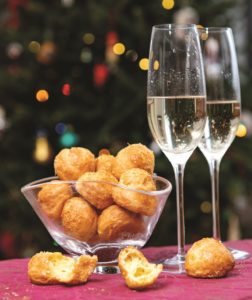Of all the dips, spreads, noshes, and nibbles I have served, there is one that I make for holiday parties year after year: gougères. They always get raves. Gougères are the little black dress of hors d’oeuvres. Simple and elegant, they’re the ideal complement to New Year’s Eve champagne or cocktails with friends.
My love affair with these cheese puffs started 20 years ago in Paris. I was a culinary student, and we were given a behind-the-scenes tour of the kitchen at the then three-Michelin-starred Taillevent restaurant. I watched as a tall handsome cook nonchalantly set a huge pan of warm-from-the-oven golden pastry puffs on the counter. It must have held 50 of them, each one perfectly round and identical to the next. I am sure he winked as he sneaked one to me. It was heavenly — a sphere of warm cheese, butter, and air.

Gougères are wondrous things. The dough seems hopelessly dense, but the moisture in it creates steam that puffs each dollop into a crisp orb with a slightly gooey hollow center. It is culinary magic. Yet they are way easier to make than pie dough or delicate cakes. When I worked at a New York cooking school, pâte à choux, of which gougères are a variation, was the first lesson in pastry because it is an easy win for beginning cooks.
These delicate bites need only pantry ingredients: butter, flour, eggs, and grated cheese. The key step might feel a bit wonky. But there is no getting around the fact that the eggs must be beaten into the dough one at a time. If they’re added in one fell swoop, the gougères won’t puff. When the first egg is added, it will slosh around, and the dough will separate into blobs. It looks wrong. Don’t panic — just keep mixing until the egg is fully incorporated. Then repeat with each egg to make a tight batter.
To make the classic version, the cheese should be a nutty Gruyère. I use Comté, or a mix of cheddar and Parmigiano-Reggiano. Really, whatever I have. Pecorino and lots of black pepper nods to caccio e pepe. Sometimes I add Dijon mustard, fresh gratings of nutmeg, or minced herbs.
Gougères need no embellishment and are best served fresh and warm from the oven. If all you serve at your New Year’s Eve party is a platter of chilled Wellfleet oysters and a plate of these, people will remember it as a fabulous fête.
If you feel a need to step it up, note that gougères are cousins to cream puffs. Split and fill cooked ones with soft goat cheese or creamy diced mushrooms, a bit of cranberry chutney with apple, or a mustard-y turkey or ham salad.
If you’re a do-ahead party type, there’s one more thing to love about gougères. They can be baked ahead and frozen. Spread them out on a pan and reheat them in a 300-degree oven while your guests hang up their winter coats and you pop the bubbly.
Gougères
Makes about 40 bites
1 cup water
½ stick (2 oz.) unsalted butter, diced
½ tsp. kosher salt
Pinch cayenne
1 cup all-purpose or bread flour
4 large eggs
1 cup (3 oz.) finely grated Gruyère
Grated nutmeg, optional
About 3 Tbsp. finely grated Parmigiano-Reggiano
- Heat oven to 425° F. Warm the water, butter, salt, and cayenne in a saucepan over medium-high heat, stirring until the butter melts and the water starts to boil. Take the pan off the heat, dump in the flour, and using a sturdy wooden spoon, stir into a smooth paste. Return the pan to medium heat and continue to mix, turning and flattening the ball of dough on the bottom of the pan with the spoon. Cook the paste until it leaves a light film on the pan and a nice buttery sheen on your finger, about 1 to 2 minutes.
- Transfer the dough to a stand mixer fitted with the paddle attachment and beat to cool slightly, about 30 seconds. If you don’t have a mixer, go old-school and continue beating with a wooden spoon. Add the nutmeg, if using.
- Crack the eggs into a measuring cup that has a spout. While mixing, pour in the first egg. The batter will resist the egg, but keep mixing. Once the egg is incorporated, pour in the next egg and mix again. Repeat with the third egg.
- Stop mixing. Lift the paddle or spoon and see how the dough falls — it should be thick and tight. Lightly beat the remaining egg, add about three quarters of it to the dough, reserving the rest for glazing the gougères. (If the dough is runny, add only half of the last egg.). Stir in the grated Gruyère.
- Transfer to a pastry bag with a half-inch round tip or a large resealable plastic bag with the corner snipped off. (Dropping rounds formed with spoons or a cookie scoop is also fine.) Hold the bag about an inch over a parchment-lined baking sheet and pipe plump rounds about the size of cherries, spacing them about 1½ inches apart. If they look like pointy gnomes or have rough edges, they can be smoothed out when brushing with the egg.
- Brush the gougères with the reserved beaten egg. Sprinkle each with a pinch of Parmigiano. Bake until puffed and beginning to brown, about 20 minutes. Serve warm.



